This was published 1 year ago
How Bondi Icebergs morphed from somewhere to swim into a place to heal
Swimming is about more than exercise. It’s about solace, meditation, emotional sustenance. And at this picturesque pool on the edge of Australia’s most famous beach, it’s also about community.
By David Leser
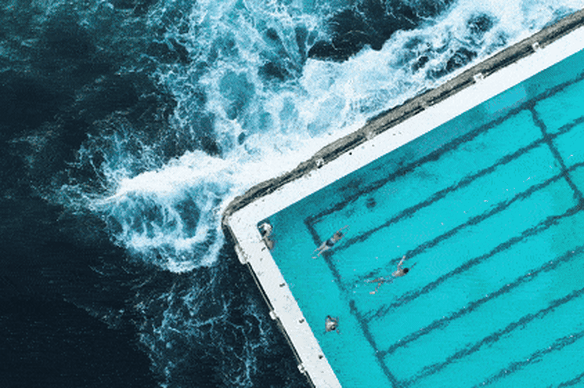
Bondi Icebergs is the belle of Sydney’s ocean baths – and will soon be the star of its own documentary.Credit: Tom Compagnoni
This is a love story and if the pool could speak, she might testify to all the loves she has witnessed – and inspired – over nearly a century: the love of ocean water, pure and simple. The love of stretching out, weightless in a trail of bubbles, of drinking in the sun, of braving the cold dark of winter, of competing – and gathering afterwards – with friends and family, of chance encounters with unforgettable strangers: all the connective threads that weave together to form a community here on the eastern rim of a continent.
And the losses, too – the bereavements and sorrows that routinely spill unseen into the saltwater, only to be washed away by the next tide: a camino trail of tears emptying into the Pacific.
Bec Key, senior lifeguard here at Bondi Icebergs, will tell you, reluctantly, and only after gentle coaxing, that this pool literally rescued her soul when her beloved son James took his life three years ago. Key had always been a strong swimmer but never more urgently than since that shattering day in June 2021, shortly after Sydney’s second COVID lockdown began. Now she swims at dawn six mornings a week, lap after lap, sending her love, heartache and incomprehension into the ocean pool before her work day begins.
“The passing of my son was something I could never have imagined happening to me,” she tells Good Weekend, “but this place definitely steered me in the right path. I don’t know if I would be here if it weren’t for the pool.”
Key learnt to swim here as a little girl, in the old-school way, courtesy of her one-legged swimming coach Phil Rothman, a former president of Icebergs Club. “He’d just shove you with his crutch and send you flying into the pool,” she says drily.
Sydney artist Georgia Zweep learnt to swim in similar fashion – her father tossing her into the water before she’d learnt to walk. And like Bec Key, she has swum – still swims – through the grief of losing her 12-year-old daughter Margot seven years ago to a rare form of brain cancer.
“After the death of a child, the swim [was] the one thing that pulled me through,” she says now, her eyes drifting across the pool that she laps 20 times each day. “I couldn’t have gone on without the swim.”
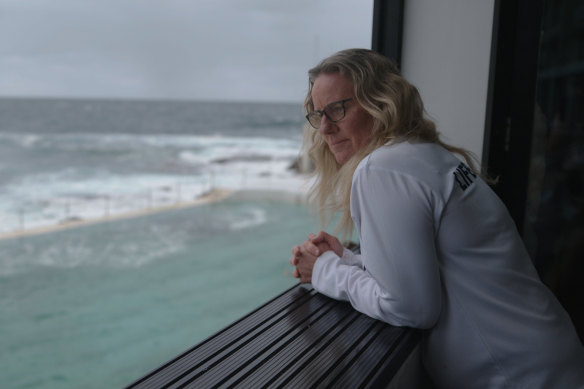
Bondi Icebergs senior lifeguard Bec Key, who has swum at dawn six times a week since the death of her son James.Credit: From The Pool.
Zweep pauses to watch youthful figures gambolling in the water on what is a perfectly scripted autumnal morning. “People just enjoy the fun of it,” she says, “but to me there’s something a lot deeper going on. It’s almost symbolic. We are from the water and made of water ... and when we get into the water it washes us clean. It’s not just your body, but your mind. It’s like a friend. Sometimes it’s amniotic, sometimes it’s primordial, sometimes it feels like a religious experience.”
Swimming as breathing, swimming as meditation, swimming as contemplation. Swimming to relax, to cope, to compete, to focus, to stay sane, to keep living. Swimming to forget, or to remember.
Sydney photographer Jason McCormack was plunged into a crushing depression when his father, Eric, died in 2016. For 18 months he kept his ashes by his bed, until a friend suggested he might want to farewell him with a ceremony. McCormack chose to spread his father’s ashes into the sea at the southern end of Icebergs pool, below a jumble of ancient, battered rocks.
“Just as we put them in the water,” he recalls, “the wind came up and I inhaled him and they went in my nostril and in my mouth. So he’s living within me. But ... it was good for me and now when I swim, I’m swimming with him every day.“
Swimming as prayer.
May my ashes, when you have them, friend,
and give them to the ocean,
leap in the froth of the waves,
still loving movement,
still ready, beyond all else,
to dance for the world.
(Prayer by Mary Oliver)
No city in the world is as flagrantly spoilt for ocean pools as Sydney. Travel its glittering coastline – from Cronulla’s Shelly Park Beach in the south to Palm Beach in the north – and you’ll find more than 30 of them, sculpted into the cliffs and rock platforms, each possessed of its own arresting beauty and character, almost winking at you, beckoning you to enter.
So many pools that you could sing paeans to each one: the triangular-shaped Fairy Bower Rockpool in Manly, with its curious sea nymph sculptures; the “swimming hole heaven” of Bronte Baths carved under an overhang of rocks; the perfect rectangle of Mona Vale Rockpool, set in a dark outcrop at the northern end of the beach; the “wild child” of Wylie’s Baths in Coogee, where all kinds of sea life can enter with the next high tide.
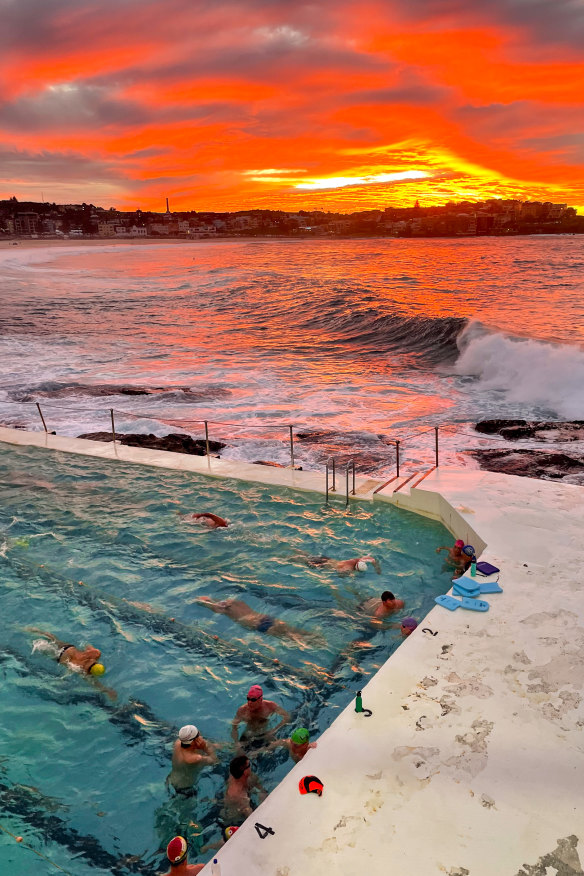
“We wake up, we come down here, we look at the ocean, we see the sunlight reflect off the ocean, we immerse ourselves in Dr Pacific and it cures a lot of ills,” says actor Russell Cheek.Credit: Ian Darling
But of all these testaments to loveliness and good fortune, Bondi Icebergs is surely the belle of the ball, not just because she looms and lounges so regally at the southern end of Australia’s most famous beach, but because she is simply too stunning for words, and probably her own good, judging by the multitudes who descended on her this past summer.
“This is our spiritual home,” says actor Russell Cheek, who comes here every morning to swim with his friend, art dealer Adrian Newstead. “We wake up, we come down here, we look at the ocean, we see the sunlight reflect off the ocean, we immerse ourselves in Dr Pacific and it cures a lot of ills.”
‘Coming from Melbourne, I didn’t know people could swim all year round.’
Filmmaker Ian Darling
“This pool is the most beautiful swimming pool I’ve ever swum in,” says Sydney filmmaker Ian Darling. “Every time I walk in here, I feel like I’m in a film from the ’60s. It feels like a safe place. It feels like a pocket of joy, but it also changes its personality on a daily basis. It’s a sun trap. It’s wild. And you’re open to all the elements. So, in and of itself, the pool is an incredibly beautiful, changing character, just like nature and the environment.”
Darling grew up in Melbourne and it was in 1992, at the age of 30, while living in Sydney temporarily, that he discovered Bondi for the first time. “It happened to be a particularly sunny winter,” he tells Good Weekend, “and I went down one day and had a body surf and I remember saying afterwards, ‘How long has this been happening?’ Coming from Melbourne, I didn’t know people could swim all year round, and I knew from that winter that I would never return to Melbourne.”
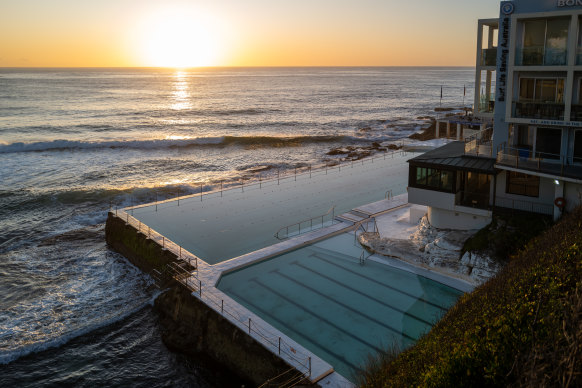
Filmmaker Ian Darling, who made The Pool, calls Icebergs “the most beautiful swimming pool I’ve ever swum in … It feels like a pocket of joy.”Credit: Ian Darling
It took another 30 years for Darling to turn his filmmaker’s eye on Icebergs. It was late 2021 and Sydney was emerging from 107 days of COVID lockdown, and Darling was just about to turn 60. He already had a swag of beautifully directed documentaries under his belt, including the award-winning The Final Quarter about racism and its effect on champion AFL footballer Adam Goodes, as well as a trilogy of films on homelessness and child protection. (Darling is a friend of mine, and 10 years ago I worked on a documentary with him about Australian singer-songwriter Paul Kelly.)
Darling had also just spent months appearing on stage around the country playing himself in a two-hander called The Twins, an exploration of love, loss, memory and regret. What more was there to do except rest or, perhaps, squeeze the creative juices further, only this time with a less burdensome subject?
“I was down at Icebergs,” Darling recalls, “and chatting with one of the regulars and champion swimmers there, Margie Simpson-Lee, and talking about what I was looking for and there it was, the pool, right under my nose, smiling at me, asking me to tell its story.”
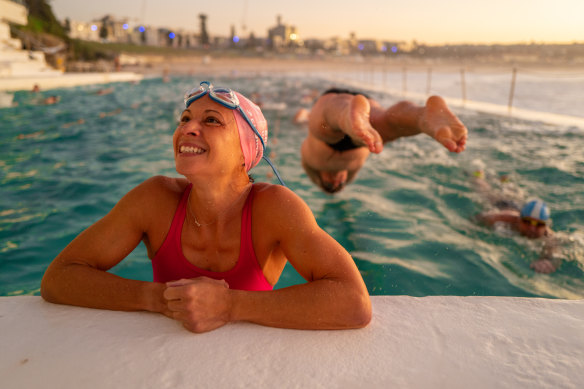
Margie Simpson-Lee in her “happy place”, where she swum every day during her pregnancies.Credit: Ian Darling
Simpson-Lee remembers the moment. “I said to him, ‘What about this pool? What about this amazing community’ ... because he’d been talking about doing a happy film and this is a happy place.”
So happy that on the day Simpson-Lee gave birth to each of her sons by caesarian section, she couldn’t resist first swimming 20 laps. “I swam every single day here with my sons during my pregnancies, and then on the day both sons [Archie and Oscar] were born, I came down here to get my kilometre in, go to the coffee shop [the Crabbe Hole] to have my last meal before fasting, then go into theatre. It was as close to water births as I could have had.”
How do you make a film about the most photographed swimming pool in the world? Do you go back to when First Nations people swam in natural rock pools and the Bondi Valley was a patchwork of tree-lined inland lakes and lagoons providing local clans with shelter, fresh water and abundant sources of food? [They called it “Boondi” because it meant “water tumbling over rocks”, and the “noise made by sea waves”.]
Do you try to capture the changing face of a beachside suburb that went from 19th-century farmland and sand dunes to Depression-era devastation, to Roaring Twenties dance-hall fever, onto postwar European migration and the arrival of Jewish Holocaust survivors, through to the 1970s when the place was known as “Scum Valley” because it was so full of rubbish and broken families, and the sea smelt like a toilet, at least on a wet day? (The opening of Bondi’s deep ocean outfall in 1992 fixed that almost instantly.)
Maybe you would finish that roll call of years with scenes of brashness and glamour as Bondi transformed itself from a working-class suburb into an elite coastal village with unaffordable [for most] real estate and impossibly sculpted bodies clothed during summer in next to nothing, as well as the location for television series including Bondi Vet, Bondi Rescue, Bondi Ink Tattoo, Being Lara Bingle, The Block ...
How would you convey the history of surfing, surf lifesaving, ocean swimming, swimming clubs, and the 69 years of prohibition when swimming during daylight hours was seen as an offence to public decency? What about the heatwaves, the shark attacks, the suicides, the drownings, the rescues? Because when you meet Peter Long, who’s been swimming in this pool and across this bay for decades, he can tell you some memorable tales.
“This woman just jumped off the rocks one evening about 6 o’clock,” he says, “and I dived in and grabbed hold of her and she said, ‘let me go’ and I said, ‘what’s wrong?’ And she said, ‘I’m going to kill myself’ and I said, ‘no you’re not.’ ”
And Long, a former big-wave surfer, helped get this young woman onto the beach where ambulance officers managed to sedate her. “Then about a year later,” Long continues, “I was down at the beach and I saw her. She’d become a member of the North Bondi Surf Life Saving Club, and I went over and spoke to her and she hugged me and said, ‘Oh thank you, thank you’ and I actually cried.”
Do you tell stories like these because they’re too precious not to tell, or do you just focus on the pool itself and how it went from the misshapen 30-metre rockpool of the late 1800s to the renovated eight-lane, 50-metre beauty it is today? And how, in 1929, it became the first licensed winter swimming club in the world, albeit one without women. (It took the 700 male club members more than six decades to allow their wives and daughters to join them in the water.)
“When the swimmer in lane one hit the ice-chilled water about 10.30am yesterday [May 7, 1995],” The Sydney Morning Herald reported the following day, “her splash signalled the end of 66 years of male-only tradition at one of the world’s most famous winter swimming clubs.”
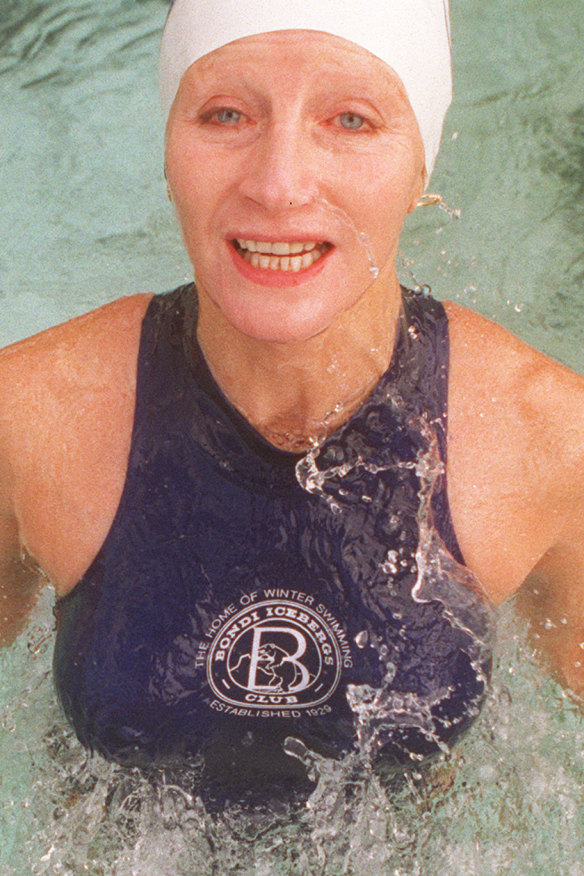
Swimmer Maggi, photographed in 1995, became the first woman since the club’s 1929 foundation to swim competitively as an Iceberg.Credit: Paul Jones
How appropriate, then, that actor-producer Margot Robbie could turn up poolside last year in a body-hugging black-and-white dress to promote her patriarchy-busting new film Barbie; and that, today, 50 per cent of the members are women, with Lynne Fitzsimons the first female president of the club.
And what about the Puffers, those men and women who don’t just swim in the pool, they swim from the pool – across the bay and back each morning – braving rips, sharks, bluebottles, jellyfish and the murky depths?
And the champions who have graced this pool? Do you mention that Margaret Whitlam [née Dovey], the Bondi-born wife of former prime minister Gough Whitlam, trained here for years, as did four-times Olympic gold medallist Murray Rose? Or that American-born swimmer Dori Miller swam up to six hours a day here in the dead of winter in order to prepare for her successful double crossing of the English Channel in 2014?
Or might you just create a film about Neil Rogers – one-time fastest butterfly swimmer in the world and arguably one of the most beloved figures at Icebergs – who died last month of cancer, aged 70. “Being down here is like a built-in yoga retreat every day,” he told Darling during filming. “You’ve got the nice fresh air and the sunrises. It’s postcard-perfect. A lot of pluses going forward, not many negatives.”
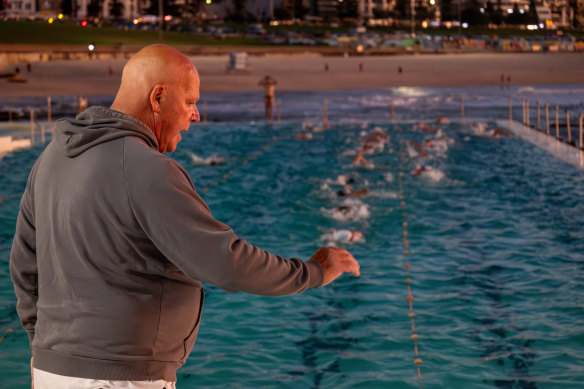
Neil Rogers, one-time fastest butterfly swimmer in the world and a beloved coach at Icebergs. He died last month, aged 70, of cancer.Credit: Ian Darling
Yes, maybe just settle on this beautiful, big-hearted man – the “Buddha of the Bergs” as some referred to him – who went from Olympic and Commonwealth Games glory to coaching all kinds of swimmers – four-year-olds to 90-year-olds – in all kinds of weather, just for the pure pleasure of it.
And speaking of weather, just how did those Italian engineers construct that outer pool wall during the 1920s, making it strong enough to withstand everything the Pacific Ocean could hurl at it?
Ian Darling got a taste of nature’s ferocity during his 100 days of filming, and it helped shape what his film would ultimately become, which is nothing less than an exquisite meditation on swimming and the power and spirit of place. The ancient Romans called this spirit of place genius loci to describe where the gods dwelt.
“There are many storm sequences in the film,” he says, “but there was one incredible day where the beach was closed and the waves were soaring over Ben Buckler [Bondi’s northern headland] and people at the cafe here were getting wet. The waves were up to 10 metres and they were crashing over the pool with a force and crack that was deafening to the ears.
“It was so exciting to see. We stayed there the whole day and saw the storm getting bigger, and as the tide went up, the waves went higher and then it gradually abated, and within a period of a few minutes this incredible rainbow appeared, going all the way from the north end of Bondi to the south, this complete rainbow. It was a reminder of the beauty we were dealing with and that the pool itself was able to observe this every single day.
“That was one of the first clues that the members come and go, the swimmers come and go, but the one thing that’s basically been here for 100 years has been that pool. And it seemed to me that the pool should be the central character and that, as filmmakers, we had to be there every day to capture it.”
Here’s a belated admission. Bondi Icebergs is possibly my favourite place in the world. I never saw it coming, but over the past seven years this eight-lane stretch of turquoise, nestled against white-washed rocks – yes, it could be Santorini or a polar bear enclosure – has turned out to be my daily anchor, the place where I train, swim, meditate, drink the best coffee in Sydney (thank you, Andrew Crabbe) and stare out at the wild blue yonder.
No two days are alike. One minute the pool is a blue-green lake, calm and silken above a truculent ocean, the next, the waves are surging over the wall and the pool and ocean have merged into a soup of heaving foam and white water.
“This place is magic,” says Ben Cush, manager and co-owner with wife Lauren of Icebergs Gym, surely the most perfectly positioned gym in the world. (The two met and fell in love right here above the pool.) “Even when it’s shit, it’s magic.”
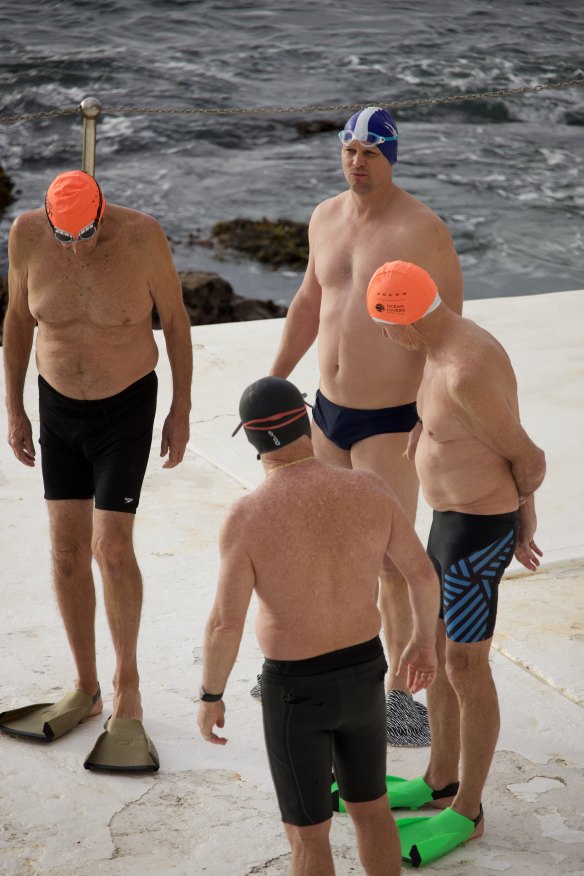
The manager and co-owner of Icebergs Gym, Ben Cush (in blue cap), hanging pre-swim with mates.Credit: Ian Darling
And that’s the other thing. There are people here who have now become integral to my world. Some, I’m still getting to know; others, well, their stories could fill an anthology of Australian profiles. Most mornings, it’s almost impossible to start a workout – or to leave – given that each person is a conversation waiting to happen. “Morning Campbell.” “Hi Jeanette, you still going to India next week?” “Hey Pete ... Bill”. “Hello Matt, how’s Lisa?” “Rex, Augustus, have you both been away again?” “Morning Remo, Mel.” “Hi Bec, done your laps this morning?” “Yes, Junia, I’m still taking the neurocalm, thank you.” “Morning Sam, you’re not still reading Dostoevsky are you?” “Morning Alan, Gavin, Jason, Peter, Evie, Todd, how was the Bay this morning?”
Then there’s Ben Cush, son of teachers, cattle farmer from Kingaroy, Queensland, but also a magnificent swimmer who’s more than happy to tell you about the time he nearly beat Ian Thorpe in a race. Cush was playing for the Cronulla Sharks and, during an after-match recovery session, saw Thorpe training in the same pool. Egged on by his teammates, the farmer issued the five-time Olympic gold medallist a challenge: 25 metres freestyle, no diving, just a push-off.
“I said to Thorpie, ‘Don’t muck around because I can swim and if you let me go, I’ll get you.’ ” And Cush, who first learnt to swim in Dalhousie Springs in central Australia – very nearly did. “We’re neck and neck,” says Cush, “and it’s almost a dead heat. He gets me by this much and then he pops his head over the lane rope and says, ‘You’ve got to join our relay team. You can actually swim.’ ” And Cush, still wearing his football shorts, replies: “I told you I could swim.”
And you can see in Ian Darling’s film, The Pool, Cush gliding and flexing through the water, sleek as a fish, before returning to the gym to take his clients through their paces. “Every single walk of life can be found within these four walls,” he says over breakfast before flying back to his farm to artificially inseminate 69 of his maiden heifers. “They’re all here – judges, politicians, bankers, plumbers, brickies, electricians, journalists, pilots, models, influencers, you can just keep going, and there used to be a lot more gangsters here too.”
What happened to them? “It was pretty much like dealing with cattle,” Cush replies. “If you get rid of one problem cow the other five pull their heads in.”
I’m not sure about you but I don’t normally have conversations about cows, clean-up bulls and gangsters – along with global politics and love – in the one morning with the same person.
“How’s your heart,” Cush often asks me, and that’s not because he thinks I’ve had a heart attack. Then in the next breath he’ll say: “Now, get your f---ing arse into that water and do 10 laps, you lazy prick.” And for some reason, I comply.
Then there’s men like Jimmy Robison, who was rushed to hospital over the summer and was dead within a few weeks. One day he was sitting there, gazing out to sea in his habitual place, wearing his pink budgie smugglers, yellow sunglasses and straw hat. Then he was gone, at 81.
Robison had lived his whole life in Bondi and in his prime had been a top sportsman – tennis, cricket, golf, big-wave surfing in Hawaii – and one of the handsomest men you could ever meet. He had a killer smile and a glad-eye for the girls (they for him, too) and he adored Buddy Greco, the American lounge singer famous for songs such as Let’s Love. Robison was a lover – of people and of the sea – and a few months before he died, I managed to convince him to get out of Bondi for one night and come with me to Camelot Lounge in Marrickville to hear Baby et Lulu, the faux French musical band, perform. “Oh f---, you’ve got me crying now,” he said during their rendition of La Ballade De La Mer [The Ballad of the Sea] and it might have been the moment that clinched our unlikely friendship.
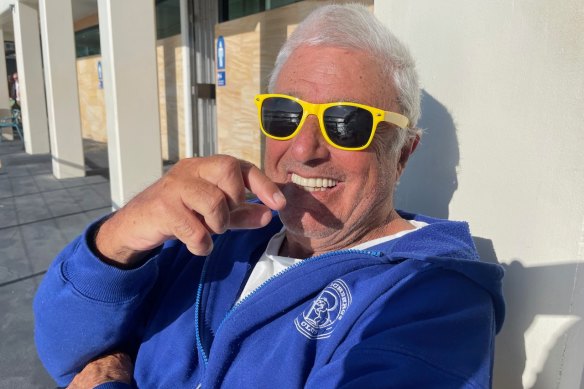
The day after Jimmy Robison’s death last summer, someone placed his white plastic chair and straw hat in its usual position, looking out over the pool.Credit: Ian Darling
When I saw him in hospital for the last time, I said, “I’ve loved our friendship Jimmy, but I have to say goodbye now,” and he replied, still smiling: “For god’s sake David, just piss off,” and so I did, and he did, too, the very next night.
The morning after his death, the tide at Bondi Beach was as low as I’d ever seen it, and Icebergs Pool was full of incapable swimmers and Instagrammers taking selfies around the perimeter. Jimmy would have hated it, but he would have loved the fact that someone had placed his white plastic chair and straw hat in its usual position, looking out over the pool and a wild warm sea.
I am sitting with Ian Darling, talking about the making of his film – and the writing of this story – and how it has helped both of us to see with fresh eyes and to pay closer attention to all the weather patterns and changing colours that so magically rearrange themselves here.
“How many kinds of blue can you see out there?” I ask him as we peer across the pool, ocean and sky. We begin trading hues of blue – aquamarine, turquoise, chemical, ceramic, midnight, metallic ... a rhapsody in blue and that’s before we’ve begun counting greens.
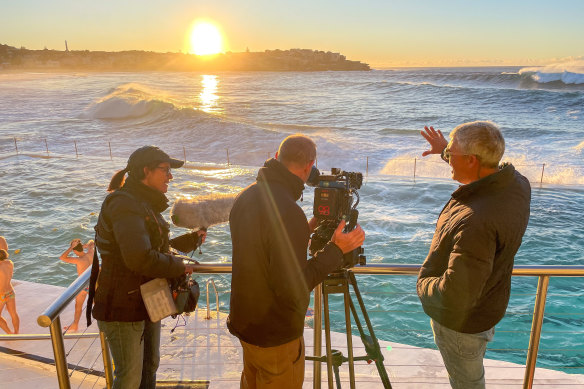
Ian Darling (right) directing The Pool’s 12-month, entirely outdoors shoot.Credit: Courtesy of Shark Island
I have felt myself changing during the course of writing this story. Like the late American poet Mary Oliver, I want to rise earlier in the day to begin looking at the world more intimately; to get down to the pool sooner, so as to see the darkness opening into morning, the sky awash with colour, the sea already doing its “daily work”.
I want to live more inside one of her poems because it’s a sweeter place to be, particularly given that it was only yesterday – as I write this – that six people were murdered up the road, among them Dawn Singleton, the daughter of businessman John Singleton, who helped save and restore this place at the turn of the century. I’m trying – as Mary Oliver wrote – to compare “human nature to the ocean from which we came”, to see how “the sea can do craziness”, how it can “rise, ebb and froth” like “an incoming frenzy of fountains”, or “it can sweet-talk entirely”.
It is a morning for sweet talk as Darling and I share what community has come to mean to us both – this community – and about the longing we all have to connect, particularly after the isolation of COVID. True, this is a famous pool overlooking a famous beach, but it is really just a distillation of some of the things we love as Australians – the sun and the sea, and the preciousness of friends with all their quiet unsung stories.
Jimmy Robison is no longer gazing out at the Pacific, and his friend and fellow Icebergs stalwart Edwin “Lord Ted” Wildie is no longer doing his laps. He died last month at the age of 85, four days before Neil Rogers took his last breath at 70.
Time drains from the clock and one day we’ll be gone, too, but the pool – with all its healing powers – will still be here, large enough to contain all the joys and sorrows of those lucky enough to find her.
The Pool premieres at the Sydney Film Festival on June 8, with other festivals and a national cinema release to follow.
To read more from Good Weekend magazine, visit our page at The Sydney Morning Herald, The Age and Brisbane Times.